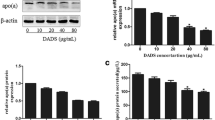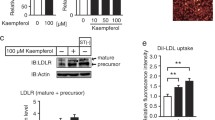Abstract
Apolipoprotein M (apoM) is a relatively novel apolipoprotein that plays pivotal roles in many dyslipidemia-associated diseases; however, its regulatory mechanisms are poorly understood. Many cytokines have been identified that down-regulate apoM expression in HepG2 cells, among which transforming growth factor-β (TGF-β) exerts the most potent effects. In addition, c-Jun, a member of the activated protein 1 (AP-1) family whose activity is modulated by c-Jun N-terminal kinase (JNK), decreases apoM expression at the transcriptional level by binding to the regulatory element in the proximal apoM promoter. In this study, we investigated the molecular mechanisms through which TGF-β decreases the apoM level in HepG2 cells. The results revealed that TGF-β inhibited apoM expression at both the mRNA and protein levels in a dose- and time-dependent manner and that it suppressed apoM secretion. These effects were attenuated by treatment of cells with either SP600125 (JNK inhibitor) or c-Jun siRNA. 5Z-7-oxozeaenol [(a TGF-β-activated kinase 1 (TAK-1) inhibitor)] also attenuated the TGF-β-mediated inhibition of apoM expression and suppressed the activation of JNK and c-Jun. These results have demonstrated that TGF-β suppresses apoM expression through the TAK-1-JNK-c-Jun pathway in HepG2 cells.





Similar content being viewed by others
Abbreviations
- apo:
-
Apolipoprotein
- AP-1:
-
Activated protein 1
- AS:
-
Atherosclerosis
- EGF:
-
Epidermal growth factor
- EMT:
-
Epithelial-Mesenchymal Transition
- ERK1/2:
-
Extracellular signal-regulated kinase 1/2
- HDL:
-
High-density lipoprotein
- HDL-C:
-
High-density lipoprotein-cholesterol
- HGF:
-
Hepatic growth factor
- JNK:
-
C-Jun N-terminal kinase
- LXR:
-
Liver X receptor
- MAP3 K:
-
Mitogen-activating protein kinase kinase kinase
- NO:
-
Nitric oxide
- PI3K:
-
Phosphatidylinositol 3-kinase
- p-JNK:
-
Phosphorylated JNK
- RCT:
-
Reverse cholesterol transport
- RXR:
-
Retinoid X receptor
- S1P:
-
Sphingosine-1-phosphate
- TAK-1:
-
TGF-β-activated kinase 1
- TBS-T:
-
Tris-buffered saline
- T-JNK:
-
Total JNK
- TNF-α:
-
Tumor necrosis factor alpha
- TGF-β:
-
Transforming growth factor beta
References
Xu N, Dahlback B (1999) A novel human apolipoprotein (apoM). J Biol Chem 274:31286–31290
Schlehuber S, Skerra A (2005) Lipocalins in drug discovery: from natural ligand-binding proteins to “anticalins”. Drug Discovery Today 10:23–33
Christoffersen C, Jauhiainen M, Moser M, Porse B, Ehnholm C, Boesl M, Dahlback B, Nielsen LB (2008) Effect of apolipoprotein M on high density lipoprotein metabolism and atherosclerosis in low density lipoprotein receptor knock-out mice. J Biol Chem 283:1839–1847
Barter PJ, Brewer HB Jr, Chapman MJ, Hennekens CH, Rader DJ, Tall AR (2003) Cholesteryl ester transfer protein: a novel target for raising HDL and inhibiting atherosclerosis. Arterioscler Thromb Vasc Biol 23:160–167
Christoffersen C, Nielsen LB, Axler O, Andersson A, Johnsen AH, Dahlback B (2006) Isolation and characterization of human apolipoprotein M-containing lipoproteins. J Lipid Res 47:1833–1843
Christoffersen C, Obinata H, Kumaraswamy SB, Galvani S, Ahnstrom J, Sevvana M, Egerer-Sieber C, Muller YA, Hla T, Nielsen LB, Dahlback B (2011) Endothelium-protective sphingosine-1-phosphate provided by HDL-associated apolipoprotein M. Proc Natl Acad Sci USA 108:9613–9618
Kurano M, Hara M, Tsuneyama K, Sakoda H, Shimizu T, Tsukamoto K, Ikeda H, Yatomi Y (2014) Induction of insulin secretion by apolipoprotein M, a carrier for sphingosine 1-phosphate. Biochim Biophys Acta 1841:1217–1226
Desmouliere A, Geinoz A, Gabbiani F, Gabbiani G (1993) Transforming growth factor-beta 1 induces alpha-smooth muscle actin expression in granulation tissue myofibroblasts and in quiescent and growing cultured fibroblasts. J Cell Biol 122:103–111
Yoon YS, Lee JH, Hwang SC, Choi KS, Yoon G (2005) TGF beta1 induces prolonged mitochondrial ROS generation through decreased complex IV activity with senescent arrest in Mv1Lu cells. Oncogene 24:1895–1903
Zhang YE (2009) Non-Smad pathways in TGF-beta signaling. Cell Res 19:128–139
Mu Y, Gudey SK, Landstrom M (2012) Non-Smad signaling pathways. Cell Tissue Res 347:11–20
Yamaguchi K, Shirakabe K, Shibuya H, Irie K, Oishi I, Ueno N, Taniguchi T, Nishida E, Matsumoto K (1995) Identification of a member of the MAPKKK family as a potential mediator of TGF-beta signal transduction. Science 270:2008–2011
Kajino T, Omori E, Ishii S, Matsumoto K, Ninomiya-Tsuji J (2007) TAK1 MAPK kinase kinase mediates transforming growth factor-beta signaling by targeting SnoN oncoprotein for degradation. J Biol Chem 282:9475–9481
Keshet Y, Seger R (2010) The MAP kinase signaling cascades: a system of hundreds of components regulates a diverse array of physiological functions. Methods Mol Biol 661:3–38
Kim SI, Kwak JH, Zachariah M, He Y, Wang L, Choi ME (2007) TGF-beta-activated kinase 1 and TAK1-binding protein 1 cooperate to mediate TGF-beta1-induced MKK3-p38 MAPK activation and stimulation of type I collagen. Am j physiol Renal physiol 292:F1471–F1478
Kipari T, Cailhier JF, Ferenbach D, Watson S, Houlberg K, Walbaum D, Clay S, Savill J, Hughes J (2006) Nitric oxide is an important mediator of renal tubular epithelial cell death in vitro and in murine experimental hydronephrosis. Am J Pathol 169:388–399
Ma FY, Tesch GH, Ozols E, Xie M, Schneider MD, Nikolic-Paterson DJ (2011) TGF-beta1-activated kinase-1 regulates inflammation and fibrosis in the obstructed kidney. Am J Physiol Renal Physiol 300:F1410–F1421
Wang W, Zhou G, Hu MC, Yao Z, Tan TH (1997) Activation of the hematopoietic progenitor kinase-1 (HPK1)-dependent, stress-activated c-Jun N-terminal kinase (JNK) pathway by transforming growth factor beta (TGF-beta)-activated kinase (TAK1), a kinase mediator of TGF beta signal transduction. J Biol Chem 272:22771–22775
Pulverer BJ, Kyriakis JM, Avruch J, Nikolakaki E, Woodgett JR (1991) Phosphorylation of c-jun mediated by MAP kinases. Nature 353:670–674
Liu J, Minemoto Y, Lin A (2004) c-Jun N-terminal protein kinase 1 (JNK1), but not JNK2, is essential for tumor necrosis factor alpha-induced c-Jun kinase activation and apoptosis. Mol Cell Biol 24:10844–10856
Binetruy B, Smeal T, Karin M (1991) Ha-Ras augments c-Jun activity and stimulates phosphorylation of its activation domain. Nature 351:122–127
Xu N, Hurtig M, Zhang XY, Ye Q, Nilsson-Ehle P (2004) Transforming growth factor-beta down-regulates apolipoprotein M in HepG2 cells. Biochim Biophys Acta 1683:33–37
Mosialou I, Krasagakis K, Kardassis D (2011) Opposite regulation of the human apolipoprotein M gene by hepatocyte nuclear factor 1 and Jun transcription factors. J Biol Chem 286:17259–17269
Wei DH, Zhang XL, Wang R, Zeng JF, Zhang K, Yang J, Li S, Lin XL, Jiang ZS, Wang GX, Wang Z (2013) Oxidized lipoprotein(a) increases endothelial cell monolayer permeability via ROS generation. Lipids 48:579–586
Wolfrum C, Poy MN, Stoffel M (2005) Apolipoprotein M is required for prebeta-HDL formation and cholesterol efflux to HDL and protects against atherosclerosis. Nat Med 11:418–422
Xu N, Nilsson-Ehle P, Ahren B (2006) Suppression of apolipoprotein M expression and secretion in alloxan-diabetic mouse: partial reversal by insulin. Biochem Biophys Res Commun 342:1174–1177
Ren K, Tang ZL, Jiang Y, Tan YM, Yi GH (2015) Apolipoprotein M. Clinica Chimica Acta Int J Clin Chem 446:21–29
Di D, Wang Z, Liu Y, Luo G, Shi Y, Berggren-Soderlund M, Nilsson-Ehle P, Zhang X, Xu N (2012) ABCA1 upregulating apolipoproein M expression mediates via the RXR/LXR pathway in HepG2 cells. Biochem Biophys Res Commun 421:152–156
Hu YW, Wang Q, Ma X, Li XX, Liu XH, Xiao J, Liao DF, Xiang J, Tang CK (2010) TGF-beta1 up-regulates expression of ABCA1, ABCG1 and SR-BI through liver X receptor alpha signaling pathway in THP-1 macrophage-derived foam cells. J Atheroscler Thromb 17:493–502
Zhang X, Zhu Z, Luo G, Zheng L, Nilsson-Ehle P, Xu N (2008) Liver X receptor agonist downregulates hepatic apoM expression in vivo and in vitro. Biochem Biophys Res Commun 371:114–117
Melhuish TA, Chung DD, Bjerke GA, Wotton D (2010) Tgif1 represses apolipoprotein gene expression in liver. J Cell Biochem 111:380–390
Luo G, Shi Y, Zhang J, Mu Q, Qin L, Zheng L, Feng Y, Berggren-Soderlund M, Nilsson-Ehle P, Zhang X, Xu N (2014) Palmitic acid suppresses apolipoprotein M gene expression via the pathway of PPARbeta/delta in HepG2 cells. Biochem and biophys research commun 445:203–207
Tan NS, Michalik L, Di-Poi N, Ng CY, Mermod N, Roberts AB, Desvergne B, Wahli W (2004) Essential role of Smad3 in the inhibition of inflammation-induced PPARbeta/delta expression. EMBO J 23:4211–4221
Chen WX, Zhang ZG, Ding ZY, Liang HF, Song J, Tan XL, Wu JJ, Li GZ, Zeng Z, Zhang BX, Chen XP (2016) MicroRNA-630 suppresses tumor metastasis through the TGF-beta- miR-630-Slug signaling pathway and correlates inversely with poor prognosis in hepatocellular carcinoma. Oncotarget 7:22674–22686
Xia Y, Karin M (2004) The control of cell motility and epithelial morphogenesis by Jun kinases. Trends Cell Biol 14:94–101
Parseghian S, Onstead-Haas LM, Wong NC, Mooradian AD, Haas MJ (2014) Inhibition of apolipoprotein A-I expression by TNF-alpha in HepG2 cells: requirement for c-jun. J Cell Biochem 115:253–260
He W, Cronstein BN (2012) Adenosine A1 receptor regulates osteoclast formation by altering TRAF6/TAK1 signaling. Purinergic Signalling 8:327–337
White BJ, Tarabishy S, Venna VR, Manwani B, Benashski S, McCullough LD, Li J (2012) Protection from cerebral ischemia by inhibition of TGFbeta-activated kinase. Exp Neurol 237:238–245
Robertson AK, Rudling M, Zhou X, Gorelik L, Flavell RA, Hansson GK (2003) Disruption of TGF-beta signaling in T cells accelerates atherosclerosis. J Clin Investig 112:1342–1350
Lin HM, Lee JH, Yadav H, Kamaraju AK, Liu E, Zhigang D, Vieira A, Kim SJ, Collins H, Matschinsky F, Harlan DM, Roberts AB, Rane SG (2009) Transforming growth factor-beta/Smad3 signaling regulates insulin gene transcription and pancreatic islet beta-cell function. J Biol Chem 284:12246–12257
Christoffersen C, Nielsen LB (2012) Apolipoprotein M–a new biomarker in sepsis. Crit Care 16:126
Acknowledgements
The authors and co-workers gratefully acknowledge research funds provided by the National Natural Science Foundation of China (Nos. 81270360 and 31400652), the Scientific Research Fund of the Hunan Provincial Education Department (13C838), the Science and Technology Planning Project of the Hunan Provincial Science and Technology Department (2014FJ2012), the Natural Science Foundation of Hunan Province (No. 14JJ2084), the Aid Program for Science and Technology Innovative Research Team in Higher Educational Institutions of Hunan Province (2008-244), and the Construct Program of the Key Discipline in Hunan Province, China (Basic Medicine Sciences of University of South China, Xiangjiaofa; No. [2011]76).
Author information
Authors and Affiliations
Corresponding author
Ethics declarations
Conflict of interest
The authors declare that there are no conflicts of interest.
About this article
Cite this article
Ren, K., Mo, ZC., Liu, X. et al. TGF-β Down-regulates Apolipoprotein M Expression through the TAK-1-JNK-c-Jun Pathway in HepG2 Cells. Lipids 52, 109–117 (2017). https://doi.org/10.1007/s11745-016-4227-9
Received:
Accepted:
Published:
Issue Date:
DOI: https://doi.org/10.1007/s11745-016-4227-9




